July 19 show
From family grocers to supermarkets
For about 103 years, the Italian ancestors of Tom Castaldi were in the food business, primarily in Logansport, where they owned neighborhood grocery stores. Beginning in the 1880s, his great-grandparents' store sold not just "fruits, vegetables, tobaccos, but also ice cream and (even) featured an oyster bar," according to Tom.
Not only is Tom Castaldi (who grew up in Logansport and lives today in Fort Wayne) the Allen County historian, he has become an expert about the heyday of neighborhood groceries.
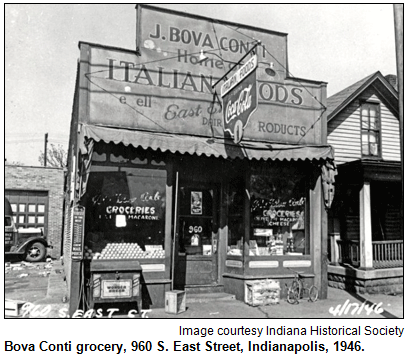 For generations, these family-owned stores were cherished in neighborhoods and villages across the state, from Lockerbie and Broad Ripple in Indianapolis to Logansport, where a candy case from the final Castaldi family's store is displayed at the Cass County Historical Museum.
For generations, these family-owned stores were cherished in neighborhoods and villages across the state, from Lockerbie and Broad Ripple in Indianapolis to Logansport, where a candy case from the final Castaldi family's store is displayed at the Cass County Historical Museum.
In addition to exploring family-run grocery stores and their social impact, Hoosier History Live also will delve into the entree across Indiana of grocery chains, including those that eventually introduced the supermarket concept.
Indianapolis-based writer, researcher and editor Sharon Butsch Freeland (writer of numerous Historic Indianapolis articles) dug into the entrance of Cincinnati-based Kroger in the Indy market for a Feb. 12, 2013, article at historicindianapolis.com.
According to Sharon's thoroughly researched piece, Kroger entered the Indianapolis market clear back in the mid-1920s by acquiring an existing family-owned chain of 72 neighborhood groceries. So the initial Kroger stores in the Hoosier capital undoubtedly were located in small storefronts; the supermarket concept was introduced later.
Tom and Sharon will join Nelson in studio to share insights about family-owned neighborhood groceries and their modern-era successors, the supermarket chains. This show undoubtedly will include tidbits about the evolution of the ways Hoosiers have shopped, cooked and lived.
Some history facts:
 According to a recent column in The Indianapolis Business Journal by Greg Andrews, Marsh Supermarkets made retailing history 40 years ago. An executive in June 1974 at the Indiana-based chain made the first purchase in the country using a UPC bar code. (He bought a pack of Juicy Fruit chewing gum to test the brand-new scanner at a Marsh store.)
According to a recent column in The Indianapolis Business Journal by Greg Andrews, Marsh Supermarkets made retailing history 40 years ago. An executive in June 1974 at the Indiana-based chain made the first purchase in the country using a UPC bar code. (He bought a pack of Juicy Fruit chewing gum to test the brand-new scanner at a Marsh store.)- Our guest Sharon Butsch Freeland is a seventh-generation Hoosier; her family has been in Indianapolis for six of those generations.
- During the 103-year stretch in the food business, our guest Tom Castaldi's family had a total of eight stores in Logansport. On only two occasions, though, were two stores operating simultaneously.
Tom's great-grandfather, Lorenzo Solimano, had been born in Genoa, Italy in 1838. With his wife Mary, Lorenzo (who changed the spelling to Laurence) opened the first Logansport store in the 1880s. The last store was closed in 1983. The exhibit about the stores at the Cass County Historical Museum is titled "Growing Up Grocery."
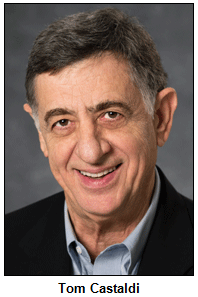 "Customers came in the neighborhood store up to the counter and gave their list of items - one by one - to the owner or clerk, who, in turn, fetched them off the shelf and stacked them on the counter," Tom recalls.
"Customers came in the neighborhood store up to the counter and gave their list of items - one by one - to the owner or clerk, who, in turn, fetched them off the shelf and stacked them on the counter," Tom recalls.
He adds: "My grandfather or father may not find it unusual to see hardware items in a modern 'mega-market.' But they would be rather surprised that I got my flu and shingles shots in a grocery pharmacy department."
The debut of the supermarket concept - which involves customers helping themselves to spacious aisles of products in a free-standing store with its own expansive, often four-sided parking lot - is unclear.
According to some accounts, the A&P chain introduced the supermarket concept in the 1930s in Pennsylvania. Other accounts point to a Kroger store in the Queens borough of New York City, also in the 1930s. The supermarket concept grew rapidly after World War II.
According to Sharon's research, a pivotal episode in the Indy area was the opening of a so-called "drive-in" Kroger (that is, a store with its own, expansive parking lot), which made the front page of The Indianapolis News in 1932.
"Before the 1930s, most grocery stores were narrow storefronts in commercial buildings that also contained other types of businesses, or groceries were rooms added on to the fronts of residences," Sharon notes. 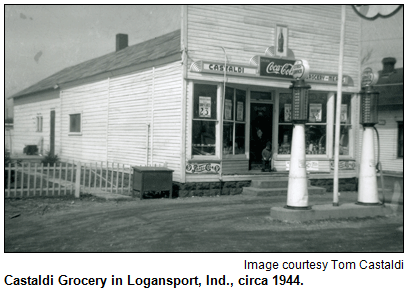 "Customers walked or took a bus to the nearest neighborhood business to get their goods, and usually bought only what they needed for that day or a few coming days."
"Customers walked or took a bus to the nearest neighborhood business to get their goods, and usually bought only what they needed for that day or a few coming days."
In 1931, Marsh had opened its first store; it was in Muncie. According to an article in The Indianapolis News in 1961, at which point the chain had 65 stores in five states, the first Marsh in Indy opened at East 52nd Street and Keystone Avenue in 1957. (Generations of family ownership of Marsh ended in 2006 when the company was purchased by Sun Capital Partners, based in Florida.)
O'Malia Food Markets made its debut in 1966 with a grocery in Carmel. Generations of Indy shoppers also patronized Atlas at East 54th Street and College Avenue (where a teenage David Letterman was a clerk in the 1960s), and Guidone, a grocery store at East 10th Street and Arlington Avenue owned by Italian immigrant Joe Guidone that was popular during the 1960s and '70s.
Small, family-owned stores of yore like the ones owned by the Italian ancestors of our guest Tom Castaldi often offered two cherished services, he notes: "No-interest credit and home delivery."
However, Tom notes the selection of grocery items was limited compared to modern supermarkets.
"Perhaps the neighborhood grocery had two types of pork and beans, or green beans, in cans on the shelf. Now the 'mega-stores' have shelving in rows as long as our entire building, with many brands of the same vegetable type."
He describes his growing-up years in a house adjacent to his family's grocery store this way: "It was like having a huge pantry available."
History Mystery
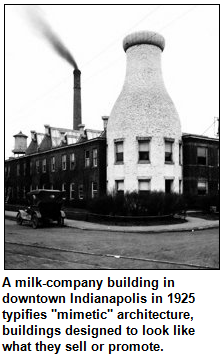 In the 1890s, a Civil War resident living in Greenwood started a dairy business that became one of the best-known in Central Indiana for more than 60 years.
In the 1890s, a Civil War resident living in Greenwood started a dairy business that became one of the best-known in Central Indiana for more than 60 years.
The dairy's headquarters on East 15th Street in Indianapolis was particularly memorable. Its corners were shaped like giant milk bottles. At stables nearby, the dairy kept horses to deliver milk to customers.
At one point, the dairy became the largest milk company in the state. It was sold in 1963 to Maplehurst Jersey Farms.
Question: What was the dairy?
The call-in number is (317) 788-3314. Please do not call into the show until you hear Nelson pose the question on the air, and please do not try to win the prize if you have won any other prize on WICR during the last two months.
The prize pack includes a gift certificate to McNiven's restaurant and two passes to the Indianapolis Zoo, courtesy of Visit Indy, and four passes to the Indiana Experience, courtesy of the Indiana Historical Society.
Roadtrip: More Swiss adventures, and 'bird town' designation
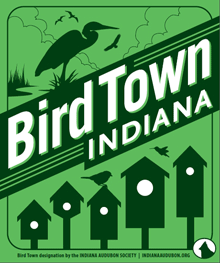 Guest Roadtripper Terri Gorney of Fort Wayne, who also volunteers at several conservation organizations, including ACRES, DNR and Limberlost, adds to last week's Berne report with notice of its upcoming Swiss Days festival on July 24, 25 and 26.
Guest Roadtripper Terri Gorney of Fort Wayne, who also volunteers at several conservation organizations, including ACRES, DNR and Limberlost, adds to last week's Berne report with notice of its upcoming Swiss Days festival on July 24, 25 and 26.
Terri reports that Swiss Days are celebrated with authentic Swiss costumes, great foods, crafts and merchandise, and you can also enjoy polka, accordions, gospel singers, a quilt show, an antique tractor and engine show, sawmill demonstrations, cheese making, wiener-dog races, sand sculptures, kid's tractor pull and a parade. Indiana certainly cherishes its many ethnic traditions.
During the festival, Berne will also be named "Bird Town No. 7" by the Indiana Audubon Society. This is a designation awarded to those communities that demonstrate an ongoing commitment to the protection of birds. Other "Bird Town" Hoosier communities include Geneva, Chesterton, Rome City, Nashville, Fort Wayne and Kendallville.
Your Hoosier History Live! team,
Nelson Price, host and creative director
Molly Head, producer, (317) 927-9101
Richard Sullivan, webmaster and tech director
Pam Fraizer, graphic designer
Garry Chilluffo, creative consultant
Joan Hostetler, Michele Goodrich, Jed Duvall, Dana Waddell, advisors
www.hoosierhistorylive.org







Please tell our sponsors that you appreciate their support: Bose McKinney & Evans LLP | Indiana Historical Society | Kurt Vonnegut Memorial Library | Lucas Oil | Story Inn | The Fountain Square Theatre Building

 Acknowledgments to Monomedia, Visit Indy, WICR-FM, Fraizer Designs, Heritage Photo & Research Services, Derrick Lowhorn and many other individuals and organizations. We are an independently produced program and are self-supporting through organizational sponsorships and individual contributions. We do not receive any government funding. Visit our website to learn how you can support us financially. Also, see our Twitter feed and our Facebook page for regular updates.
Acknowledgments to Monomedia, Visit Indy, WICR-FM, Fraizer Designs, Heritage Photo & Research Services, Derrick Lowhorn and many other individuals and organizations. We are an independently produced program and are self-supporting through organizational sponsorships and individual contributions. We do not receive any government funding. Visit our website to learn how you can support us financially. Also, see our Twitter feed and our Facebook page for regular updates.
July 26 show - encore presentation
Indy Mayor Ballard on Marines history and 'old' Cathedral High
An Indianapolis native, he grew up on the Eastside, attended the "old" Cathedral High School (when it was located downtown and had all male students) and eventually enlisted in the U.S. Marine Corps.
 So there's much local history turf to cover with Mayor Greg Ballard of Indianapolis when he joins Nelson in-studio for an encore presentation of a show that explores history topics that have been intertwined with his life. (The original air date of this show was June 15, 2013.)
So there's much local history turf to cover with Mayor Greg Ballard of Indianapolis when he joins Nelson in-studio for an encore presentation of a show that explores history topics that have been intertwined with his life. (The original air date of this show was June 15, 2013.)
You won't want to miss Mayor Ballard's recollections of incidents that unfolded during the years that he hitchhiked from his Eastside neighborhood to Cathedral. Like generations of teenage boys before him who attended the downtown Cathedral, Greg Ballard, a member of the Class of '72, relied primarily on hitchhiking to get to and from school for four years.
During the show, Mayor Ballard, now 59, also shares details about the unlikely way his decision to enlist in the Marines occurred. After a 23-year military career, Mayor Ballard, a Republican, retired as a lieutenant colonel from the Marines in 2001 and returned to his hometown to enter private business.
He also discusses other links between the Hoosier state and Marines, in addition to sharing his own experiences. 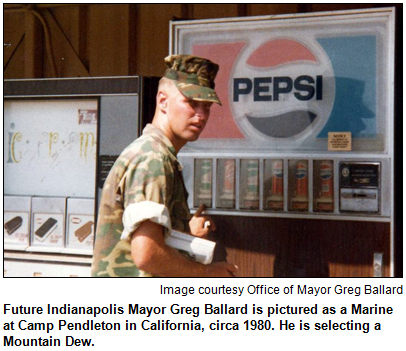 His decision to enlist eventually led to assignments in places such as Okinawa, Japan; Saudi Arabia during the first Persian Gulf War; and Stuttgart, Germany, as well as in Michigan and North Carolina.
His decision to enlist eventually led to assignments in places such as Okinawa, Japan; Saudi Arabia during the first Persian Gulf War; and Stuttgart, Germany, as well as in Michigan and North Carolina.
Before that, the future mayor attended Cathedral on a scholarship. His years there were preceded and followed by major changes. Since its founding in 1918, Cathedral had been located at 14th and Meridian streets.
In 1976, four years after he graduated, Cathedral merged with Ladywood, an all-girls Catholic academy located on the northeastside, a decision that was presented as a financial necessity for both schools. (The merged, co-ed school, which took the Cathedral name, is on the former Ladywood site on East 56th Street.) Previously, while Greg Ballard was attending Cathedral, Ladywood had merged in 1971 with Cathedral's "sister" school downtown, St. Agnes Academy.
Greg Ballard grew up in a family of five children. After graduating from Cathedral, he attended Indiana University, where a pivotal event occurred related to his decision to join the Marines. He had never run for political office before defeating incumbent Bart Peterson in the 2007 mayoral election in what has been called one of the biggest upsets in Indy's political history.
© 2014 Hoosier History Live! All rights reserved.